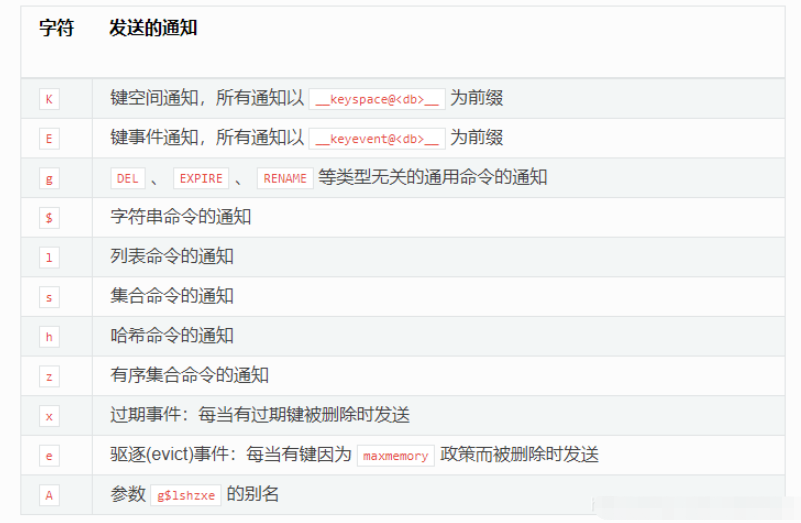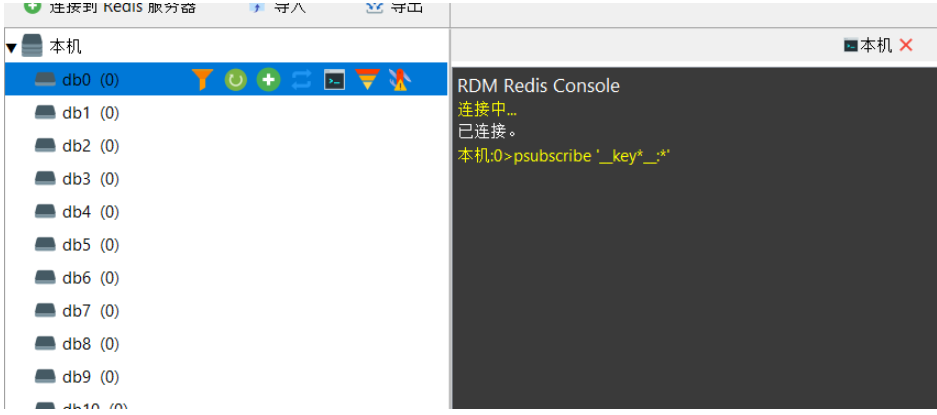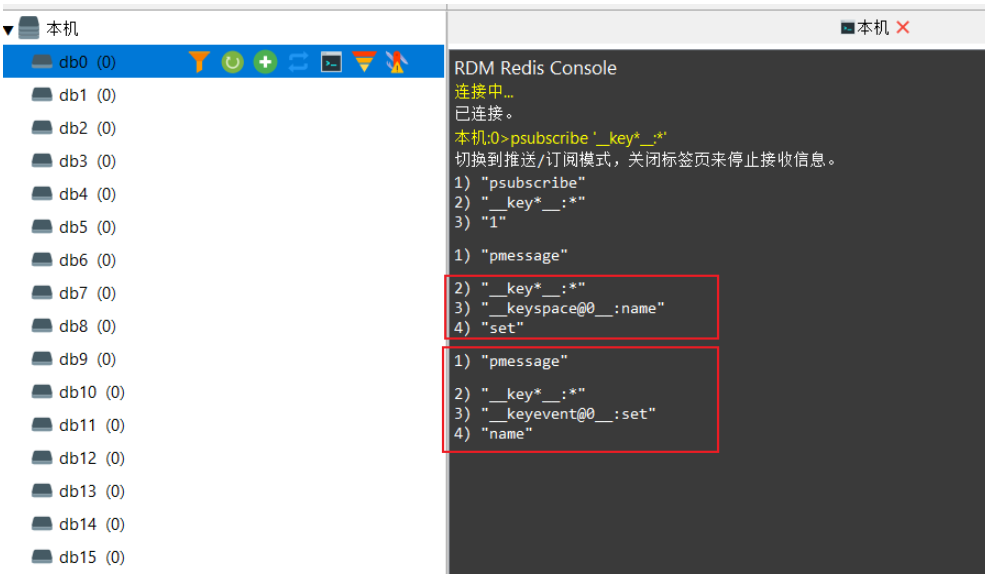How SpringBoot monitors redis Key change events
1. Function Overview
Key space notification allows the client to receive events that have changed the Redis key in some way by subscribing to the channel or mode.
All commands that modify key keys.
All keys that receive the LPUSH key value [value …] command.
All expired keys in the db database.
Events are distributed through the subscription and publishing functions (pub/sub) of Redis, so all clients that support the subscription and publishing functions can directly use the key without making any modifications. Space notification function.
Because the current subscription and publishing functions of Redis adopt a fire and forget strategy, if your program requires reliable notification of events, then the current key space notification may Not suitable for you: When a client subscribed to events goes offline, it loses all events that were distributed to it during the disconnection.
In the future, more reliable event distribution will be supported. This support may be achieved by making the subscription and publishing functions themselves more reliable, or by subscribing and publishing messages in Lua scripts. Publish to listen to achieve operations like pushing events to a list.
2. Event types
For each operation that modifies the database, keyspace notifications will send two different types of events.
For example, when executing the DEL key [key …] command on the key mykey of database 0, the system will distribute two message, which is equivalent to executing the following two PUBLISH channel message commands:
1 2 |
|
Subscribing to the first channel __keyspace@0__:mykey can receive events for all modified keys mykey in database No. 0, Subscribing to the second channel __keyevent@0__:del can receive all keys that execute the del command in database No. 0.
The channel prefixed by keyspace is called key-space notification, and the channel prefixed by keyevent is called key-event notification.
When the del mykey command is executed:
Subscribers to the keyspace channel will receive the name of the event that was executed, in this example, del .
Subscribers to the key event channel will receive the name of the key for which the event was executed, in this example, mykey .
3. Configuration
Because turning on the key space notification function requires some CPU, so in the default configuration, this function is turned off.
You can turn on or off the keyspace notification function by modifying the redis.conf file or directly using the CONFIG SET command:
When the parameter of the notify-keyspace-events option is an empty string, Function is turned off.
On the other hand, when the parameter is not an empty string, the function is turned on.
The parameters of notify-keyspace-events can be any combination of the following characters, which specifies which types of notifications the server should send:

Input parameters There must be at least one K or E in it, otherwise, no matter what the other parameters are, no notification will be distributed.
For example, if you only want to subscribe to notifications related to lists in the keyspace, then the parameter should be set to Kl, and so on.
Set the parameter to a string "AKE" means sending all types of notifications.
Whenever a key is deleted due to expiration, an
expirednotification is generated.Generate an
evictednotification whenever a key is deleted to reclaim memory due to themaxmemorypolicy.
All commands will only generate notifications after the key has actually been changed.
For example, when SREM key member [member …hellip;] attempts to delete an element that does not exist in the collection, the deletion operation will fail because there is no real change to the key, so this Notifications will not be sent for the operation.
If you have any questions about the notification generated by the command, it is best to use the following command to verify it yourself:
Redis uses the following two methods to delete expired keys:
When a key is accessed, the program will check the key. If the key has expired, the key will be deleted.
The underlying system will progressively find and delete expired keys in the background to process keys that have expired but will not be accessed.
When an expired key is discovered by either of the above two programs and the key is deleted from the database, Redis will generate an expired notification.
Redis does not guarantee that a key whose lifetime (TTL) becomes 0 will be deleted immediately: if the program does not access this expired key, or if there are too many keys with lifetime, then the key The lifetime becomes 0, and there may be a significant time interval between when the key is actually deleted.
因此, Redis 产生expired通知的时间为过期键被删除的时候, 而不是键的生存时间变为 0 的时候。
三、案例
按上文内容,我们先将redis的键空间通知开启,我们开启所有的通知,在可以端中测试后没问题再到代码中测试。
连接到redis 输入一下命令

1 |
|
订阅键空间和键事件的主题

1 2 3 4 5 |
|
创建一个 key :name valus:zhangsan
1 |
|
观察订阅的窗口 会受到两个消息,第一个是:键空间 第二个是键事件,键空间是内容是操作指令,主题中包含有key,键事件主题中包含了指令,内容是key。

到这里说明已经开启了键空间通知
代码
以下代码采用string类型演示
在配置一下MessageListenerContainer类,将我们写好的监听类添加到该类中即可,删除和过期都是需要添加,我这里就一起添加了后面就不做演示。
1 2 3 4 5 6 7 8 9 10 11 12 13 14 15 16 17 18 19 20 21 22 23 24 25 26 27 28 29 30 |
|
新增和修改都是set指令
所以监听的主题都一样,实现MessageListener接口,重写onMessage这里就是收到消息的处理逻辑
1 2 3 4 5 6 7 8 9 10 11 12 13 14 |
|
在redis中对name这个key进行set操作
1 |
|
在控制台就可以看到name这个key被操作了

删除
跟上面的更新监听一样,只需要把订阅主题更改一下即可。同样需要添加到这个RedisMessageListenerContainer,上面已经添加,这里不做演示
1 2 3 4 5 6 7 8 9 10 11 12 13 14 15 16 17 18 19 |
|
在redis输入命令,del name 在控制台可以看到已经收到消息了。

过期
如上面的操作方式一样
1 2 3 4 5 6 7 8 9 10 11 12 13 14 |
|
在redis中写一个定时删除的keySETEX age 18 3三秒后就可以控制台打印了相关信息

The above is the detailed content of How SpringBoot monitors redis Key change events. For more information, please follow other related articles on the PHP Chinese website!

Hot AI Tools

Undresser.AI Undress
AI-powered app for creating realistic nude photos

AI Clothes Remover
Online AI tool for removing clothes from photos.

Undress AI Tool
Undress images for free

Clothoff.io
AI clothes remover

Video Face Swap
Swap faces in any video effortlessly with our completely free AI face swap tool!

Hot Article

Hot Tools

Notepad++7.3.1
Easy-to-use and free code editor

SublimeText3 Chinese version
Chinese version, very easy to use

Zend Studio 13.0.1
Powerful PHP integrated development environment

Dreamweaver CS6
Visual web development tools

SublimeText3 Mac version
God-level code editing software (SublimeText3)

Hot Topics
 1393
1393
 52
52
 1207
1207
 24
24
 How to build the redis cluster mode
Apr 10, 2025 pm 10:15 PM
How to build the redis cluster mode
Apr 10, 2025 pm 10:15 PM
Redis cluster mode deploys Redis instances to multiple servers through sharding, improving scalability and availability. The construction steps are as follows: Create odd Redis instances with different ports; Create 3 sentinel instances, monitor Redis instances and failover; configure sentinel configuration files, add monitoring Redis instance information and failover settings; configure Redis instance configuration files, enable cluster mode and specify the cluster information file path; create nodes.conf file, containing information of each Redis instance; start the cluster, execute the create command to create a cluster and specify the number of replicas; log in to the cluster to execute the CLUSTER INFO command to verify the cluster status; make
 How to clear redis data
Apr 10, 2025 pm 10:06 PM
How to clear redis data
Apr 10, 2025 pm 10:06 PM
How to clear Redis data: Use the FLUSHALL command to clear all key values. Use the FLUSHDB command to clear the key value of the currently selected database. Use SELECT to switch databases, and then use FLUSHDB to clear multiple databases. Use the DEL command to delete a specific key. Use the redis-cli tool to clear the data.
 How to read redis queue
Apr 10, 2025 pm 10:12 PM
How to read redis queue
Apr 10, 2025 pm 10:12 PM
To read a queue from Redis, you need to get the queue name, read the elements using the LPOP command, and process the empty queue. The specific steps are as follows: Get the queue name: name it with the prefix of "queue:" such as "queue:my-queue". Use the LPOP command: Eject the element from the head of the queue and return its value, such as LPOP queue:my-queue. Processing empty queues: If the queue is empty, LPOP returns nil, and you can check whether the queue exists before reading the element.
 How to use the redis command
Apr 10, 2025 pm 08:45 PM
How to use the redis command
Apr 10, 2025 pm 08:45 PM
Using the Redis directive requires the following steps: Open the Redis client. Enter the command (verb key value). Provides the required parameters (varies from instruction to instruction). Press Enter to execute the command. Redis returns a response indicating the result of the operation (usually OK or -ERR).
 How to use redis lock
Apr 10, 2025 pm 08:39 PM
How to use redis lock
Apr 10, 2025 pm 08:39 PM
Using Redis to lock operations requires obtaining the lock through the SETNX command, and then using the EXPIRE command to set the expiration time. The specific steps are: (1) Use the SETNX command to try to set a key-value pair; (2) Use the EXPIRE command to set the expiration time for the lock; (3) Use the DEL command to delete the lock when the lock is no longer needed.
 How to read the source code of redis
Apr 10, 2025 pm 08:27 PM
How to read the source code of redis
Apr 10, 2025 pm 08:27 PM
The best way to understand Redis source code is to go step by step: get familiar with the basics of Redis. Select a specific module or function as the starting point. Start with the entry point of the module or function and view the code line by line. View the code through the function call chain. Be familiar with the underlying data structures used by Redis. Identify the algorithm used by Redis.
 How to use the redis command line
Apr 10, 2025 pm 10:18 PM
How to use the redis command line
Apr 10, 2025 pm 10:18 PM
Use the Redis command line tool (redis-cli) to manage and operate Redis through the following steps: Connect to the server, specify the address and port. Send commands to the server using the command name and parameters. Use the HELP command to view help information for a specific command. Use the QUIT command to exit the command line tool.
 How to configure Lua script execution time in centos redis
Apr 14, 2025 pm 02:12 PM
How to configure Lua script execution time in centos redis
Apr 14, 2025 pm 02:12 PM
On CentOS systems, you can limit the execution time of Lua scripts by modifying Redis configuration files or using Redis commands to prevent malicious scripts from consuming too much resources. Method 1: Modify the Redis configuration file and locate the Redis configuration file: The Redis configuration file is usually located in /etc/redis/redis.conf. Edit configuration file: Open the configuration file using a text editor (such as vi or nano): sudovi/etc/redis/redis.conf Set the Lua script execution time limit: Add or modify the following lines in the configuration file to set the maximum execution time of the Lua script (unit: milliseconds)




